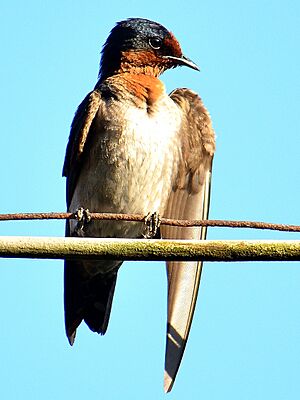Pacific swallow facts for kids
Quick facts for kids Pacific swallow |
|
|---|---|
 |
|
| At Manado, North Sulawesi | |
| Conservation status | |
| Scientific classification | |
| Genus: |
Hirundo
|
| Species: |
tahitica
|
The Pacific swallow (Hirundo tahitica) is a small passerine bird. It belongs to the swallow family. These birds live in warm areas of southern Asia and the islands of the south Pacific. They usually stay in one place all year, but some might move a little during different seasons. You often find them near coasts. However, they are now starting to live in forests higher up too.
Contents
What Does the Pacific Swallow Look Like?
This swallow is a small bird, about 13 cm (5.1 in) long. It has a shiny blue-black back and head. Its wings and tail are a bit browner. The face and throat are a bright red. The feathers on its belly are a dusky color. You can tell it apart from other swallows because its tail is shorter and not as deeply forked.
About the Pacific Swallow's Family Tree
Scientists give every animal a special name. This helps them organize and understand all living things. The Pacific swallow was officially named in 1789. A German scientist named Johann Friedrich Gmelin gave it the name Hirundo tahitica. He put it in the group of swallows called Hirundo.
There are seven different types, or subspecies, of the Pacific swallow:
- H. t. javanica – Found from south Myanmar and the Andaman Islands to south Vietnam, and east to the Philippines and south to the Moluccas and Sunda Islands.
- H. t. namiyei – Lives in the Ryukyu Islands (south Japan) and Taiwan.
- H. t. frontalis – Found in north and west New Guinea and nearby islands.
- H. t. albescens – Lives in south and east New Guinea and its surrounding islands.
- H. t. ambiens – Found on New Britain and nearby islands in the Bismarck Archipelago.
- H. t. subfusca – Lives in the Admiralty Islands, New Ireland, the Solomon Islands, and other islands like Vanuatu, Fiji, and Tonga.
- H. t. tahitica – Found on Mo'orea and Tahiti in the Society Islands.
Pacific Swallow Habits and Home
The Pacific swallow builds a neat, cup-shaped nest. They make their nests from small balls of mud. They collect the mud with their beaks. You can find these nests under cliff ledges or on buildings, bridges, or tunnels made by people. The inside of the nest is soft, often lined with feathers or grass. A female swallow usually lays two or three eggs.
These birds are very good at catching insects while flying. They are called insectivores because they eat insects. They fly very fast, catching flies and other bugs in the air. This is similar to how other swallows and swifts hunt.
Pictures of the Pacific Swallow







